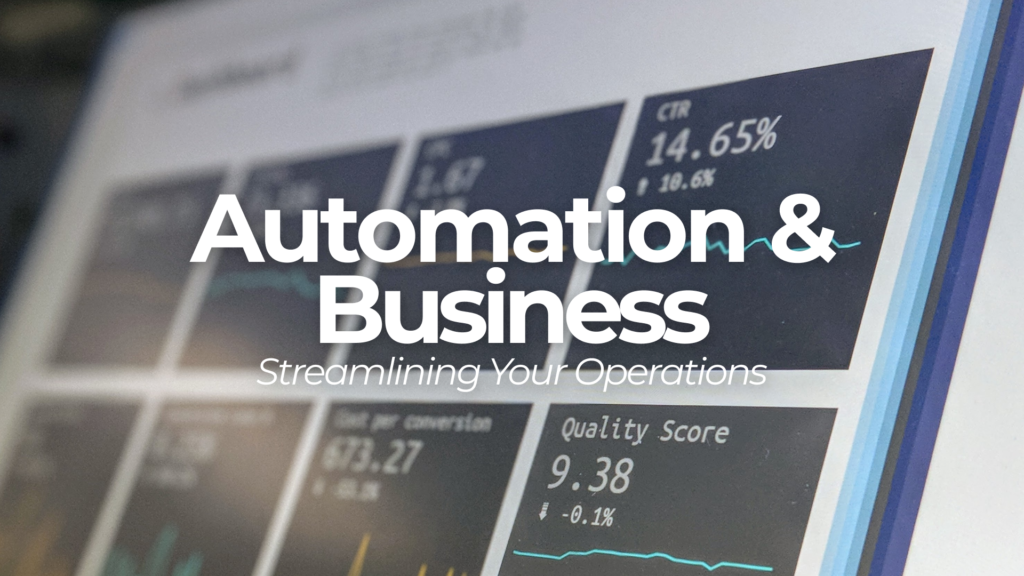In today’s fast-paced business landscape, efficiency and competitiveness are key factors for success. One of the most powerful tools at your disposal is automation. By leveraging automation technologies, you can optimise your operations, save time, and reduce costs while increasing productivity and customer satisfaction.
In this blog post, we’ll delve into the world of automation and its impact on streamlining business operations. We’ll explore how automation can transform manual, repetitive tasks into seamless, efficient processes. By doing so, you can free up valuable time and resources to focus on strategic initiatives and core competencies.
Whether you’re a small start-up or an established enterprise, understanding automation and its benefits is crucial. We will guide you through the process of identifying areas within your operations that can be automated, and provide practical examples across various industries. Additionally, we will discuss the importance of selecting the right automation tools and offer strategies for successful implementation.
Join us as we unlock the potential of automation and help you streamline your operations, paving the way for greater productivity and business growth. Let’s get started…
Understanding Automation
Automation is revolutionising the way businesses operate in today’s digital age. At its core, automation involves the use of technology and software to perform tasks and processes with minimal human intervention. By leveraging automation, you can streamline your operations, save time, and reduce costs while improving overall efficiency.
One of the key benefits of automation is the significant time savings it offers. Mundane and repetitive tasks that once required hours of manual effort can now be executed in a fraction of the time. This allows employees to focus on more strategic and value-added activities that contribute directly to the growth and success of the business.
Cost savings are another advantage of automation. By automating processes, you can reduce your dependence on manual labour, leading to decreased labour costs over time. Additionally, automation helps minimise errors and rework, which can be costly and time-consuming to rectify.
Automation can be applied to various areas of business operations, such as data entry, customer service, inventory management, and marketing. For example, customer service chatbots can handle basic inquiries, freeing up human agents to handle more complex issues. Automated inventory management systems can optimise stock levels, reducing the risk of stockouts or excess inventory.
In summary, automation offers you the opportunity to enhance productivity, efficiency, and cost-effectiveness. By understanding the potential of automation and identifying areas where it can be applied, you can unlock new levels of operational excellence. Embracing automation is not just a trend; it’s a strategic move that can propel your business forward in today’s competitive landscape.
Streamlining Operations
Streamlining operations is a crucial aspect of achieving business success. It involves optimising processes and workflows to eliminate inefficiencies, bottlenecks, and unnecessary steps. By streamlining operations, you can improve productivity, enhance customer satisfaction, and gain a competitive edge in the market.
One of the key benefits of streamlining operations is improved productivity. By eliminating redundant tasks and optimising workflows, employees can work more efficiently, accomplishing more in less time. This leads to increased output and better utilisation of resources, ultimately boosting the overall productivity of the business.
Streamlining operations also contribute to enhanced customer satisfaction. When processes are streamlined, customers experience smoother interactions, quicker response times, and more consistent service. By eliminating unnecessary delays and errors, you can provide a seamless customer experience, leading to increased customer loyalty and positive word-of-mouth recommendations.
Moreover, streamlining operations can result in cost savings. By identifying and eliminating inefficiencies, you can reduce wastage, minimise rework, and optimise resource allocation. This, in turn, leads to lower operational costs and improved profitability.
However, it is important to recognise that streamlining operations is not without its challenges. Resistance to change, lack of clear process documentation, and the need for cross-functional collaboration are common obstacles. Overcoming these challenges requires a comprehensive approach that includes effective communication, employee training, and a culture of continuous improvement.
Identifying Areas for Automation
Identifying the right areas within your business operations for automation is a crucial step in streamlining your processes. To effectively identify these areas, it’s important to conduct a thorough analysis of your existing workflows and processes.
Start by examining tasks that are repetitive, time-consuming, or prone to human error. These are often strong candidates for automation. For example, data entry and data processing tasks that involve manual input and verification can be automated using specialised software or robotic process automation (RPA) tools. This not only eliminates the risk of human error but also speeds up the process significantly.
Consider processes that involve high volumes of transactions or interactions. These can be prime targets for automation as they can benefit from the speed and efficiency of automated systems. For instance, order processing, invoicing, and payment processing can be automated to ensure accuracy, reduce processing time, and improve overall customer experience.
Another area to explore is the integration of different systems and platforms. If you find yourself spending a significant amount of time transferring data manually between various systems, it may be beneficial to automate data integration. By implementing integration solutions, such as APIs (Application Programming Interfaces) or middleware, you can streamline data flow and eliminate manual intervention.
Additionally, look for tasks that require real-time monitoring or notifications. Automating such tasks can ensure timely responses and minimise delays. For example, you can automate alerts for inventory restocking, customer support ticket escalations, or equipment maintenance reminders.
Implementing Automation Tools
When it comes to implementing automation in your business, selecting the right automation tools is crucial. These tools provide the necessary technology and functionalities to streamline your operations effectively. Here are some key considerations to guide you in the process:
First and foremost, consider the specific needs and requirements of your business. Identify the areas where automation is needed and prioritise them. Look for automation tools that align with those needs, whether it’s task automation, process automation, or data automation.
Cost is another important factor. Evaluate the pricing models of different automation tools, such as upfront costs, subscription fees, or pay-per-use options. Consider the long-term return on investment (ROI) and determine if the benefits outweigh the costs.
Scalability is essential, especially if you anticipate growth or changes in your business. Ensure that the automation tools can accommodate your evolving needs and can scale along with your operations.
Integration capabilities are critical as well. Check if the automation tools can seamlessly integrate with your existing systems and platforms. Smooth integration allows for the exchange of data and information across different tools, enabling a more unified and efficient workflow.
User-friendliness is key when selecting automation tools. Look for intuitive interfaces and user-friendly features that make it easy for your employees to adopt and utilise the tools effectively. Consider the learning curve and the availability of training resources or support from the tool provider.
Lastly, research and seek recommendations from industry peers or experts. Look for reviews and case studies to gain insights into the experiences of other businesses that have implemented similar automation tools in similar use cases.
Overcoming Challenges
Implementing automation in your business operations can bring about transformative benefits, but it’s important to be prepared for the challenges that may arise along the way. By proactively addressing these challenges, you can ensure a smoother transition and maximise the effectiveness of your automation initiatives.
One common challenge is resistance to change. Employees may feel apprehensive about the introduction of automation, fearing job displacement or a lack of control. To overcome this, it’s crucial to foster a culture of open communication and transparency. Clearly communicate the reasons behind the automation implementation, emphasising the potential benefits for both the business and the employees. Involve employees in the process, provide training and support, and highlight how automation can enhance their roles and skills.
Another challenge is the lack of clear process documentation. When automating tasks, it’s essential to have a thorough understanding of the existing processes. If processes are poorly documented or ambiguous, it can hinder the automation implementation. Invest time in documenting workflows, standardising procedures, and clarifying responsibilities. This will not only facilitate the automation process but also serve as a valuable resource for future reference and continuous improvement.
Change Management plays a critical role in overcoming challenges. Proper planning and stakeholder involvement are key. Develop a well-defined roadmap for automation implementation, including milestones and timelines. Engage employees at all levels, from executives to frontline staff, and address any concerns or questions they may have. Provide comprehensive training programs to ensure employees are equipped with the necessary skills to work alongside automation tools effectively.
Lastly, it’s important to continuously monitor and adjust the automated processes. Automation is not a one-time implementation; it requires ongoing evaluation and optimisation. Regularly assess the effectiveness of the automated workflows, gather feedback from employees, and make necessary adjustments to improve efficiency and address any unforeseen issues.
Future Trends and Considerations
As technology continues to advance at a rapid pace, it’s important to stay informed about future trends and considerations in automation. By keeping up with emerging developments, you can make informed decisions and stay ahead of the competition.
One significant trend is the rise of artificial intelligence (AI) and machine learning (ML) in automation. AI-powered automation systems can learn from data patterns, make intelligent decisions, and adapt to changing circumstances. This opens up new possibilities for advanced process automation, predictive analytics, and personalised customer experiences.
Another trend is the increasing integration of automation across different departments and functions within an organisation. Rather than isolated automation solutions, businesses are moving towards holistic automation strategies that connect various systems and processes. This enables end-to-end automation and promotes seamless information flow across the entire business ecosystem.
Considerations for the future of automation include the ethical implications of AI and automation. As automation becomes more pervasive, it’s important to address concerns around privacy, data security, and the impact on employment. Businesses must proactively implement safeguards and adhere to ethical practices to build trust and ensure responsible automation.
Additionally, as automation becomes more complex, the need for skilled professionals in areas like data analysis, AI development, and automation management will grow. Businesses should invest in upskilling their workforce to adapt to the evolving automation landscape and take advantage of the opportunities it presents.
By embracing these future trends and considerations, you can harness the full potential of automation, drive innovation, and stay agile in a rapidly changing business environment. By staying informed and proactive, you can position your organisation for success in the automation-driven future.
To Sum It Up…
Automation is a powerful tool for streamlining business operations, enhancing productivity, and staying competitive. By understanding automation, identifying areas for implementation, selecting the right tools, and overcoming challenges, you can unlock significant benefits.
Through automation, you can save time, reduce costs, and optimise processes, allowing employees to focus on strategic initiatives and core competencies. By streamlining operations and integrating automation, you can enhance customer satisfaction, increase efficiency, and achieve better financial outcomes.
Automation is not a one-time endeavour but rather an ongoing journey of continuous improvement. Regularly evaluate and optimise your automated processes to maximise their effectiveness and adapt to evolving business needs.
By leveraging automation, you’ll gain a competitive edge and be well-equipped to navigate the ever-changing business landscape with confidence. Start streamlining your operations today and embrace the power of automation to drive your business forward.
Here at Yo, we’re all about improving the success of the businesses we deal with. So, If you are interested in learning more about improving your business development, or generally future-proofing your business – enter your contact details into the form below and we’ll be in touch with how we can help you and your business TODAY!











